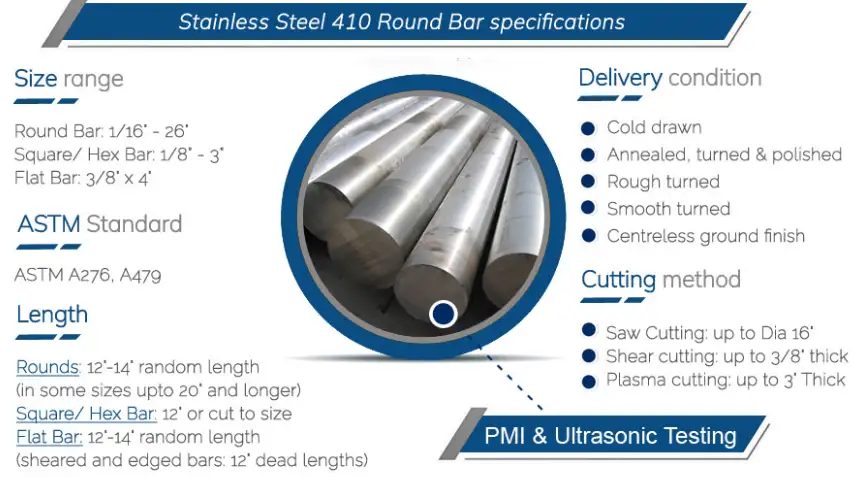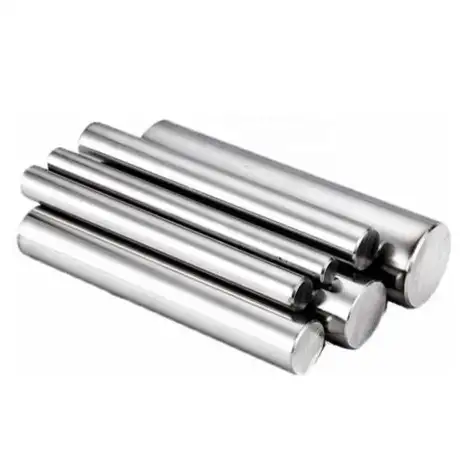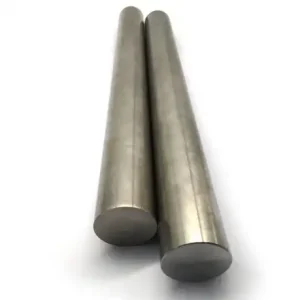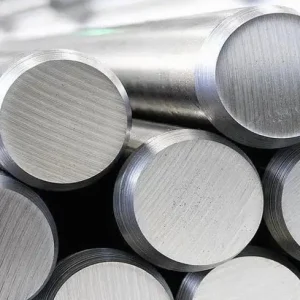410 QDT stainless steel round bar is a martensitic, quenched-and-double-tempered variant of AISI 410 optimized for higher, more consistent mechanical performance and improved resistance to untempered martensite — making it a cost-efficient choice where wear resistance, heat resistance and moderate corrosion resistance are required (including some sour-gas oil & gas components). For highly corrosive or marine environments, austenitic grades such as 304 remain superior; choose 410 QDT when strength, hardness and heat treatability are the priority and when budget or magnetic properties matter.
What “410 QDT” means?
“410” is the familiar AISI/UNS designation for a hardenable, martensitic stainless steel with chromium content in the ~11.5–13.5% range. The suffix QDT stands for Quenched and Double-Tempered — a controlled heat-treatment route applied after forming to remove untempered martensite, stabilise mechanical properties and reduce residual stress while delivering predictable hardness and toughness for corrosive or H₂S-exposed parts. The QDT variant is widely stocked as round bar in sizes used for fasteners, shafts, valve parts and downhole hardware.
Chemical composition
Below is a consolidated table capturing the commonly cited composition ranges for AISI 410 / 410 QDT as reported in multiple industry datasheets. Individual mills may supply material that sits anywhere inside these ranges; always verify mill certificates for critical applications.
| Element | Typical composition (wt.%) |
|---|---|
| Carbon (C) | 0.08 – 0.15 (max typically 0.15–0.20 depending on spec) |
| Chromium (Cr) | 11.5 – 13.5. Typical ~12.0% |
| Manganese (Mn) | ≤ 1.0 (often 0.5–1.0) |
| Silicon (Si) | ≤ 1.0 (deoxidizer levels) |
| Nickel (Ni) | ≤ 0.75 (low Ni; not an austenitic grade) |
| Phosphorus (P) | ≤ 0.04 (impurity limit) |
| Sulfur (S) | ≤ 0.03 (impurity limit) |
| Iron (Fe) | Balance (remainder) |
Specifications and cross-references
Common specifications and equivalents for 410 / 410 QDT round bar:
| Designation / Standard | Typical reference |
|---|---|
| AISI/ASTM / UNS | AISI 410 / UNS S41000 |
| EN / DIN | X12Cr13 (1.4006) |
| JIS (Japan) | SUS410 |
| China (GB) | 1Cr13 / GB/T 1220 / GB/T 20878 |
| AMS / Military | AMS 5613 / AMS 5612 (bar/rod forms) |

Mechanical properties and hardness
Below are representative property ranges for 410 QDT after quench & double-temper processing. Properties vary with tempering temperature/sequence and section size.
| Property | Typical value / range |
|---|---|
| Tensile strength (UTS) | ~480 – 700 MPa (can be higher for heavily hardened conditions). |
| Yield strength (0.2% offset) | ~275 – 450 MPa depending on heat treatment. |
| Elongation (A50) | ~10 – 20% (smaller for higher hardness conditions) |
| Hardness (Rockwell C / HRC) | Range: roughly 20 HRC (soft condition) up to ~45 HRC (hardened & tempered). QDT variants are supplied to defined hardness ranges to avoid untempered martensite. |
| Brinell hardness (HB) | varies widely — typical 200–450 HB depending on tempering and section size. |
Manufacturing and the QDT heat treatment process
-
Starting condition: Round bar is often produced in annealed/pickled condition after hot rolling. For 410 QDT the bar is then taken through quench and double tempering.
-
Quench: The bar is austenitised at a high temperature, then oil-quenched to form martensite, increasing hardness markedly.
-
Double tempering: Two tempering cycles (separate controlled reheats) are applied to temper martensite, relieve stresses and convert any retained austenite. The dual temper helps stabilise microstructure and reduce variability between lots. This is especially important for components used in sour gas (H₂S) service where untempered martensite can accelerate localized failure.
Design tips:
-
Specify QDT and the target hardness or tempering range on purchase orders for components where uniformity matters.
-
For machining, softer temper conditions make cutting easier; for wear parts, a higher tempering hardness is often requested.
-
Pay attention to section size: larger diameters cool more slowly and will have different microstructures; suppliers often give different temper schedules by section.
Typical applications and industry sectors
410 QDT round bar is chosen where a combination of hardness/wear resistance, heat resistance and moderate corrosion resistance is wanted at a lower raw material cost than nickel-bearing austenitics.
Common uses include:
-
Valves, stems, and valve seats for petrochemical and general industrial use (including some sour-gas applications).
-
Fasteners and shafts where magnetic properties are acceptable and higher strength/abrasion resistance is needed.
-
Pump components and mechanical seals (with careful corrosion engineering).
-
Downhole tools and certain oilfield parts (when specified QDT for H₂S exposure).
-
Cutlery and bearing parts in less corrosive environments where hardness is prioritized.
Selection rule of thumb: If chloride or marine corrosion is a primary concern, prefer 300-series stainless or duplex grades. Use 410 QDT when strength/wear/heat treatability and budget are the controlling constraints.
Is 410 stainless steel better than 304?
Short answer: “Better” depends on the requirement.
-
Corrosion resistance: 304 (austenitic, ~18% Cr, ~8–10% Ni) far outperforms 410 in chloride environments, seawater, and acidic atmospheres. For general corrosion resistance, 304 is superior.
-
Hardenability and wear: 410 (martensitic) can be heat-treated to hardness levels unreachable for 304; so for wear resistant or abrasion-prone parts, 410 is better.
-
Magnetism: 410 is magnetic (martensitic); 304 is generally non-magnetic (austenitic).
-
Cost: 410 is typically less expensive because it contains little or no nickel and lower alloying costs.
Decision matrix: Use 410 QDT where strength, wear, heat resistance and lower cost matter; choose 304 where corrosion resistance and formability are essential.
Corrosion, sour-gas (H₂S) considerations and limits
410 QDT is sometimes specified for components in petrochemical service, including sour environments, because the QDT route eliminates untempered martensite that can accelerate crack initiation. However, 410 is not inherently H₂S-resistant in all environments — selection must consider pH, exposure temperature, chloride content and stress level. Industry practice for sour service often prefers higher alloy materials or specific surface treatments depending on NACE/ISO guidelines. For parts in H₂S service, reference applicable NACE MR0175/ISO 15156 standards and confirm the material condition and hardness limits with materials engineers.
Global 2025 price snapshot - indicative comparison
Prices for stainless steel vary with raw material surcharges (Ni, Cr), regional demand, processing and lead time. Below is an indicative price range for 410-grade round bar / coil equivalents in 2025. These are market snapshots from supplier listings and region indices — treat them as ballpark guidance and request current quotes for procurement.
| Region | Indicative 2025 price (USD / metric tonne) |
|---|---|
| China (domestic mill / coil) | ~$1,400 – $2,300 / t (range across suppliers, quality and finishing). |
| India (domestic suppliers / rod) | ~$1,200 – $2,000 / t (local retail and mill prices vary; listed prices often in INR/kg on trade portals). |
| USA (distributor, retail bar pricing) | Retail per-piece pricing ~ $2.5 – $6.5 / kg (equivalent ~ $2,500 – $6,500 / t depending on cut-to-length, brand and inventory). IMARC price index for round bar Q2 2025: ~ $6,405 / t (June 2025). |
| Europe (service centers) | ~$2,500 – $5,000 / t (varies with alloy surcharges and finish). Surcharge schedules and supplier quotes determine final cost. |
-
These ranges are indicative and do not include machining, cutting, testing, freight, export duties or supplier markups.
-
For bulk factory orders from China (full-truck, tonne quantities), factory EXW prices will sit at the lower bound; finished and cut-to-length bars ordered from distributors in the USA/Europe will often appear at the higher bound.
Procurement notes: sizes, tolerances and finishes
-
Common round bar sizes: diameters from 3 mm up to 200 mm+ are available; stock bars are often offered in 1–6 m lengths or cut-to-length. Cold-finished (CF) and hot-rolled (HR) conditions are both offered.
-
Surface finish: pickled & oiled, cold-drawn bright (CD), turned, or polished — specify finish for tight tolerance parts.
-
Tolerances: specify ASTM/EN tolerances or custom machine tolerances for diameter, straightness and concentricity. For shafts, specify straightness and roundness limits.
-
Testing: for critical applications request MTR (chemical and mechanical) and NDT (UT, PMI) as required. For sour service, supply hardness limits and NACE compliance documentation when needed.
-
Lead time trick: buying from a Chinese mill like MWalloys in stock often gives faster turnaround and factory pricing versus going through Western distributors.
FAQs
-
What is the hardness of 410 QDT?
Typical hardness depends on tempering but ranges from roughly 20 HRC up to ~45 HRC. QDT supplies aim for a controlled hardness band — request target HRC on PO. -
What is 410 QDT stainless steel round bar used for?
Valves, shafts, fasteners, pump parts, some oilfield components requiring heat treatability and wear resistance. -
Is 410 better than 304?
For hardness/wear and heat treatability: yes. For corrosion resistance and formability: no — 304 is superior. -
What is 410 QDT equivalent to?
AISI/UNS: 410 / S41000. EN: X12Cr13 (1.4006). JIS: SUS410. China: 1Cr13. Check the exact spec (e.g., AMS 5613) for aerospace or military needs. -
Can 410 QDT be welded?
Welding martensitic steels typically requires preheat and post-weld heat treatment to avoid cracking and to re-temper martensite. Follow qualified welding procedures for 410 variants. -
Is 410 QDT magnetic?
Yes — martensitic 410 is magnetic. This can be an asset or limitation depending on the application. -
What mechanical properties can I expect?
Tensile ~480–700 MPa, yield ~275–450 MPa, elongation 10–20% (dependent on temper). Verify with MTR. -
What certifications should I request?
Mill test certificate (EN 10204 3.1/3.2), hardness report, heat treatment record, PMI/chemical analysis, and NDT if required. For sour service, ask for NACE/ISO compliance documentation. -
How does section size affect heat treatment?
Larger diameters cool more slowly during quench; this changes hardenability and may require adjusted quench media or alloy adjustments. Ask supplier for heat-treatment schedules by section. -
Where can I buy 410 QDT round bar at factory prices?
Contact mills or direct exporters in China that stock QDT bar. MWalloys supplies factory-priced 410 QDT round bars with fast stock delivery and can provide mill certs and cut-to-length services.
Why source 410 QDT from MWalloys
MWalloys is a China-based metal materials specialist offering 410 QDT stainless steel round bars with direct factory pricing. Our advantages:
-
100% factory EXW pricing for bulk and stock orders (no distributor markups).
-
Fast delivery from available inventory for common sizes.
-
Full documentation: MTRs, heat-treatment records, and cutting/processing options.
-
Custom services: machining, threading, and surface finish on request.
If you need a formal quote, specify diameter, length, finish, target hardness and quantity — MWalloys can respond with a competitive lead time and full documentation.





